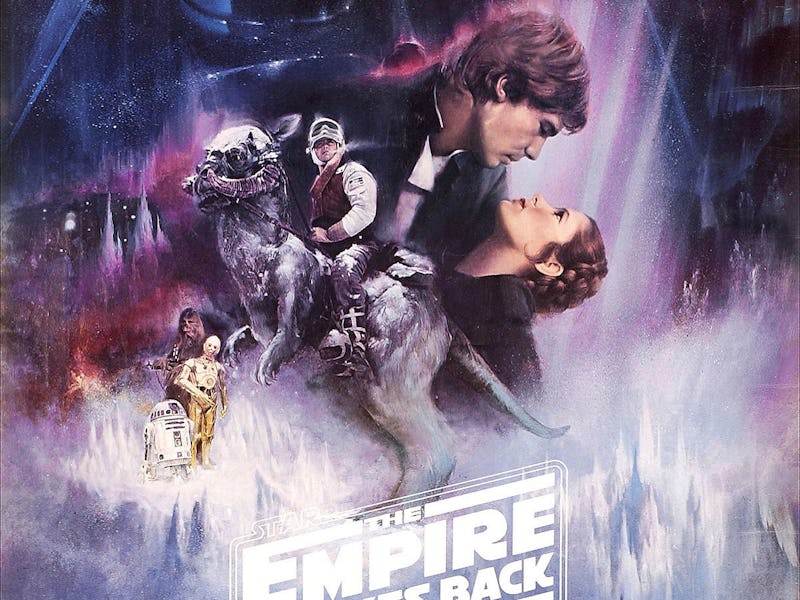'Star Wars' Began With Episode IV and How It Explains Our Cinematic Universe Obsession
George Lucas did it first.

Now that Star Wars has become a massive multi-movie, multi-billion dollar cultural force of nature stretching over nearly four decades it’s hard to remember that the original 1977 film was a standalone gamble. George Lucas focused his weird little story on a lonely farm boy caught in a massive space adventure, but shaded in the movie with allusions to unseen narrative strands, compensating for his lack of budget by hinting at further reaches of the brimming sci-fi story he was eager to tell.
We now know the answers, but imagine hearing certain details back in 1977, with absolutely zero context. The Millennium Falcon was the ship that made the Kessel Run in less than 12 parsecs? Wow, what was the Kessel Run, and what are Parsecs? Obi-Wan fought with Anakin Skywalker in the Clone Wars? What was that all about? Lucas’ self-contained movie was anything but, and preceded the far reaching mindset of the current proliferation of blockbuster universes like those manufactured by Marvel and, more recently, DC (which is a work-in-progress). But when audiences showed up to the Star Wars sequel in 1980 and the first movie’s re-release in 1981 they didn’t know that yet. It was only then that they realized their favorite cultural phenomenon was a part of a much bigger story.
It’s well-known that Lucas wanted to ape the swashbuckling aesthetic of Flash Gordon Saturday morning serials in Star Wars, but he also wanted to do it in other minutely detailed ways as well. From the outset of his career, he played with the tradition of continuing chapters in genre entertainment. It’s why he ironically put a trailer for Tragedy on Saturn, Chapter Two of Buck Rogers before his first film, THX1138. Lucas wanted that scope for Star Wars as a then faux-ongoing series, and he always envisioned it as a part of a big expansive in media res universe.
But the specifics of his story, and the potentially confusing titles of his first drafts of the script, reflect that too. There’s a randomness with which Lucas ascribed episode numbers to the early timeline of his lofty ideas. Early handwritten outlines for Star Wars had the first movie as “Episode Six,” with Lucas’ notes envisioning “Episode I” as a “prelude” to the main story. There was also a trilogy of movies that chronicled the Clone Wars in Episodes II through IV, and a concluding Episode V was planned as what Lucas called an “Epilogue” to the primary story and a “Prologue” to a whole new series. Clearly, he was juggling a lot of story ideas.
But the motif didn’t surface until January 1975 when Lucas named his space story, “Adventures of the Starkiller, Episode I: The Star Wars,” ascribing the series its first chapter number. The draft submitted to 20th Century Fox executive Alan Ladd Jr. (the man who would ultimately greenlight the movie) also featured an end credit that promised the continuing adventures of Lucas’ everyman space hero.
The exact number of the episode would change as Lucas inflated the story itself, with the writer/director finally landing on his first movie as Episode IV of the saga. But that distinction was removed from the film’s now iconic opening text crawl at the last minute. It was a consolation for movie studio Fox, the executives of which thought that audiences would rightfully be confused with the “Episode IV” title and wonder whatever happened to the non-existent first three.
Here’s how audiences saw the beginning of the movie in 1977:
But after Star Wars was released and became a resounding success many millions of times over, it gave Lucas the clout to numerically title the movies as he saw fit, and expand his series with episode titles, starting with the sequel.
The Empire Strikes Back was initially known only as “Star Wars Sequel” in its first draft by screenwriter Leigh Brackett in February 1978. But handwritten title pages by Lucas, who always wrote scripts in longhand, label the second draft of the sequel as “Episode II.” Eventually the typed second draft by co-screenwriter Lawrence Kasdan in August of that year changes to Episode V in accordance with the new numbering scheme. At that point the movie had been registered with the MPAA as “Episode II (Two): The Empire Strikes Back,” but subsequent drafts afterwards always labelled it as the fifth chapter of the series, and the movie was released theatrically as “Episode V” in its opening crawl.
The first movie is thus the only live-action Star Wars film to ever be first released without an episode number or subtitle, and only became Star Wars - Episode IV: A New Hope once it was rereleased on April 10, 1981 after the success of The Empire Strikes Back.
If anything, the retconning of the naming convention represented Lucas’ prescient idea of a cinematic universe decades before Marvel even had an idea that it could make billions upon billions of dollars doing the exact same thing. It perhaps could have only begun with The Empire Strikes Back, which provided viewers one of the greatest cliffhangers in cinema history. By its nature the movie is an incomplete story, one that could only be resolved in a subsequent episode. Imagine if The Empire Strikes Back bombed and Fox didn’t want to take a huge financial gamble on a third movie? The story’s incompleteness would have been even more evident.
In effect, The Empire Strikes Back perfected and solidified Lucas’ vision of a big-screen serial, one that retroactively changed Star Wars into Episode IV: A New Hope, which allowed Lucas to wrap things up with Episode: VI: Return of the Jedi* and eventually revisit his epic space saga in 1999 with the prequels. Though he had an idea of a cinematic universe in the late 1970s, Lucas couldn’t have dreamed that there are many more episodes to come.